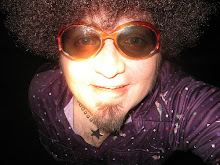 Released in 1996, this album is not from the "golden vinyl era" by any means. I just happen to have it on vinyl, since 1996 was a year of "vinyl obsession" of sorts for me and I tended to buy anything I could on LP instead of CD. Listening to this album again recently, I was reminded of how thoroughly it rocks, so I felt it needed to be resurrected.
Released in 1996, this album is not from the "golden vinyl era" by any means. I just happen to have it on vinyl, since 1996 was a year of "vinyl obsession" of sorts for me and I tended to buy anything I could on LP instead of CD. Listening to this album again recently, I was reminded of how thoroughly it rocks, so I felt it needed to be resurrected.Butter 08 was a collaboration of several musicians from different groups, including Yuka Honda and Miho Hatori from Cibo Matto, and Russell Simins from the Jon Spencer Blues Explosion. Intended to be a side project, they released only one self-titled album, on the Beastie Boys' now-defunct Grand Royal label. I was really into Cibo Matto at the time (still am), so I was compelled to see them during what was probably their only tour, at Lee's Palace in Toronto. It was an incredible, high-energy show that included a big freaky guy in a Yoda mask who busted out on stage and started jumping around and providing "yelling" vocals (you can hear him on the track "Degobrah").
The music is a mish-mash of raucous neo-punk ("9MM", "It's The Rage", "Degobrah"), laid-back lounge ("How Do I Relax"), funky guitars ("Shut Up", "Hard To Hold"), and Beck-esque lo-fi grooves ("What Are You Wearing", "Sex Symbol"). It's not for everyone, to be sure, but if you like any of these genres, or if you're a Cibo Matto fan, you'll likely dig some of the stuff from Butter 08.
Listen for the incongruous Hall & Oates homage at the beginning of "It's The Rage". They also made a video for the track "Butter 0f 69" that I didn't know about until I started writing up this blurb - it can be found here:
[Link to "Butter Of 69" video]





